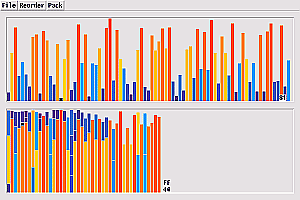Bin Packing

One-dimensional bin packing is a classic problem with many practical
applications related to minimization of space or time.
It is a hard problem for which many different heuristic solutions
have been proposed.
The goal is to pack a collection of objects into the minimum number
of fixed-size "bins".
The bpack.icn
program illustrates the behavior of six different packing algorithms.
It is a streamlined version of the older binpack program
from the Icon program library.
The Program
Two shelves of objects appear in the program display.
The top shelf shows the candidate objects to be packed.
The bottom shelf shows the results of packing.
Objects larger than half a bin are colored orange;
smaller objects are blue.
The File menu offers three choices:
About summarizes the available packing algorithms
New creates a new, random set of objects for packing
Quit exits the program
The Reorder menu rearranges the candidate objects on the top shelf.
The Pack menu selects an algorithm and packs the
objects onto the bottom shelf using the selected algorithm.
These operations are illustrated in the following sections.
The Reorder Menu
The entries in the Reorder menu rearrange the top shelf of
candidate objects in various ways.
 |
The Random entry reorders the candidate objects randomly.
|
 |
The Regular entry maximizes the distances between
similarly-sized objects, producing the pattern seen here.
|
 |
The Ascending entry orders the objects from smallest
to largest. This display also illustrates the color scheme.
|
 |
The Descending entry orders the objects from largest
to smallest. Packing is usually improved by starting with the
largest objects first.
|
The Pack Menu
The entries in the Pack menu take the objects from the top
shelf and pack them into the bottom shelf using different algorithms.
The resulting display notes the packing algorithm used by its initials,
and also indicates the number of bins required.
All algorithms take the objects from the top shelf in order and
place them one at a time.
A new bin is created whenever the algorithm cannot use an existing bin.
 |
This initial set of candidate objects is used for the
illustrations that follow.
|
 |
The First Fit algorithm places a new object
in the leftmost bin that still has room.
|
 |
The Last Fit algorithm places a new object
in the rightmost bin that still has room.
|
 |
The Next Fit algorithm places a new object
in the rightmost bin, starting a new bin if necessary.
|
 |
The Best Fit algorithm places a new object
in the fullest bin that still has room.
|
 |
The Worst Fit algorithm places a new object
in the emptiest existing bin.
|
 |
The Almost Worst Fit algorithm places a new object
in the second-emptiest bin. (This algorithm is provably better than
Worst Fit and so it is of some theoretical interest.)
|
Sorted Packing

In real applications, the sizes to be packed may all be known
in advance. In that case, better results are achieved by
packing the largest objects first. This illustration shows
the results of sorting the input in descending order before
applying the Best Fit algorithm.
Further Reading
E.G. Coffman, Jr., M.R. Garey, and D.S. Johnson.
Approximation Algorithms for Bin-Packing -- An Updated Survey.
In Algorithm Design for Computer System Design,
ed. by Ausiello, Lucertini, and Serafini. Springer-Verlag, 1984.
David S. Johnson. Fast Algorithms for Bin Packing.
Journal of Computer and System Sciences 8, 272-314 (1974).
Icon home page












